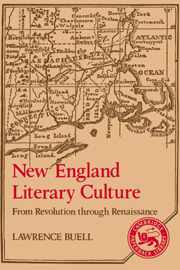Book contents
- Frontmatter
- Contents
- Acknowledgments
- Abbreviations of Frequently Cited Works
- PART I FOUR OVERVIEWS
- PART II THREE REPRESENTATIVE GENRES
- PART III REINVENTING PURITANISM: THE NEW ENGLAND HISTORICAL IMAGINATION
- Part IV NEW ENGLAND AS A COUNTRY OF THE IMAGINATION: THE SPIRIT OF PLACE
- 12 The Cultural Landscape in Regional Poetry and Prose
- 13 The Village as Icon
- 14 Lococentrism from Dwight to Thoreau
- 15 Comic Grotesque
- 16 Provincial Gothic: Hawthorne, Stoddard, and Others
- Postscript
- Appendix Vital Statistics: A Quantitative Analysis of Authorship as a Profession in New England
- Notes
- Index
16 - Provincial Gothic: Hawthorne, Stoddard, and Others
Published online by Cambridge University Press: 15 October 2009
- Frontmatter
- Contents
- Acknowledgments
- Abbreviations of Frequently Cited Works
- PART I FOUR OVERVIEWS
- PART II THREE REPRESENTATIVE GENRES
- PART III REINVENTING PURITANISM: THE NEW ENGLAND HISTORICAL IMAGINATION
- Part IV NEW ENGLAND AS A COUNTRY OF THE IMAGINATION: THE SPIRIT OF PLACE
- 12 The Cultural Landscape in Regional Poetry and Prose
- 13 The Village as Icon
- 14 Lococentrism from Dwight to Thoreau
- 15 Comic Grotesque
- 16 Provincial Gothic: Hawthorne, Stoddard, and Others
- Postscript
- Appendix Vital Statistics: A Quantitative Analysis of Authorship as a Profession in New England
- Notes
- Index
Summary
The world is so sad and solemn, that things meant in jest are liable, by an overpowering influence, to become dreadful earnest, – gayly dressed fantasies turning to ghostly and black-clad images of themselves.
Nathaniel Hawthorne, American Notebooks (1835)The music of all barbarous nations is said to be in the minor key, and there is in its dark combinations something that gives piercing utterance to that undertone of doubt, mystery, and sorrow by which a sensitive spirit always is encompassed in this life.
Harriet Beecher Stowe, Oldtown Folks (1869)By “provincial gothic,” I mean the use of gothic conventions to anatomize the pathology of regional culture. Although the phrase is uncommon, most readers will immediately and rightly associate it with such works as Emily Brontë's Wuthering Heights, Edwin Arlington Robinson's Tilbury Town poems, Edgar Lee Masters's Spoon River Anthology, Sherwood Anderson's Winesburg, Ohio, and the “southern gothic” tradition exemplified by the fiction of William Faulkner, Carson McCullers, and Flannery O'Connor. The student who wishes to understand New England's place in American literary history as a whole will have a special interest in such writing, since New Englanders produced the first sizable body of it in this country and since provincial gothic constitutes America's most distinctive contribution to the gothic tradition as a whole.
- Type
- Chapter
- Information
- New England Literary CultureFrom Revolution through Renaissance, pp. 351 - 370Publisher: Cambridge University PressPrint publication year: 1986



